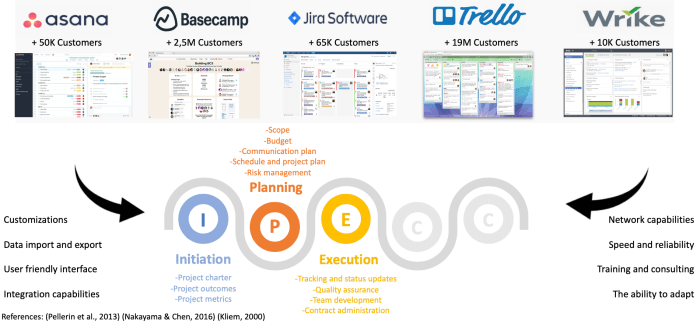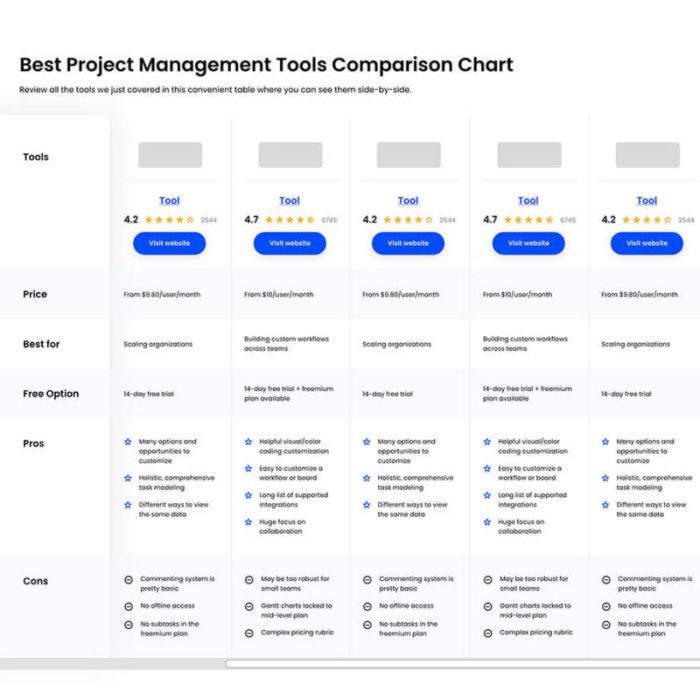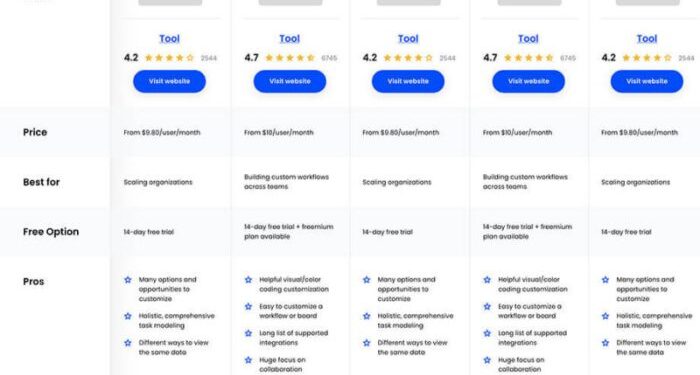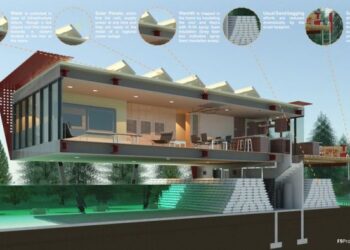Exploring the realm of Architecture project management tools comparison opens up a world of possibilities and insights. Dive into this extensive guide to discover the key features, important factors to consider, cost analysis, integration capabilities, customization options, user reviews, and more.
Overview of Architecture Project Management Tools
Architecture project management tools are software applications designed to assist architects, designers, and project managers in effectively organizing and managing various aspects of architectural projects. These tools streamline communication, collaboration, scheduling, budgeting, and resource allocation to ensure the successful completion of projects within set timelines and budgets.
Key Features of Architecture Project Management Tools
- Task and milestone tracking
- Document management and sharing
- Resource allocation and scheduling
- Budgeting and cost tracking
- Collaboration and communication tools
- Reporting and analytics capabilities
Popular Architecture Project Management Tools
1. Autodesk BIM 360
2. Procore
3. Bluebeam Revu
4. Trello
5. Asana
6. Monday.com
7. Basecamp
8. Smartsheet
9. Microsoft Project
10. CoConstruct
Comparison Criteria

When comparing architecture project management tools, several important factors need to be considered to ensure the right fit for your needs. The user interface, ease of use, collaboration features, and communication capabilities play a significant role in the effectiveness of these tools.
User Interface and Ease of Use
A user-friendly interface and ease of use are crucial when selecting an architecture project management tool. This includes the layout, navigation, and overall design of the software. A tool that is intuitive and easy to navigate can improve productivity and reduce the learning curve for team members.
Collaboration and Communication Features
Effective collaboration and communication features are essential for architecture project management tools. These features allow team members to work together seamlessly, share updates, assign tasks, and track progress in real-time. Integration with communication tools like email and messaging platforms can streamline communication and enhance team collaboration.
Cost Analysis
When it comes to architecture project management tools, understanding the cost structures is crucial for making an informed decision. Let's analyze the pricing models and any additional costs that users should be aware of.
One-time Payment vs. Subscription-based vs. Freemium Models
Architecture project management tools offer different pricing models to cater to the diverse needs of users. Here is a breakdown of the most common pricing structures:
- One-time Payment:Some tools require a one-time payment for a perpetual license, allowing users to use the software indefinitely. This can be a cost-effective option for those who prefer a one-time investment.
- Subscription-based:Many tools offer a subscription-based model where users pay a recurring fee at regular intervals, such as monthly or annually. This model often includes regular updates and customer support.
- Freemium:Freemium tools provide basic features for free, with the option to upgrade to a premium version for additional functionalities. Users can start with the free version and upgrade as needed.
Additional Costs and Hidden Fees
While the pricing models mentioned above give an overview of the initial costs, users should also consider any additional costs or hidden fees that may arise. Here are some common additional costs associated with architecture project management tools:
- Integration Costs:Some tools may require additional expenses for integrating with other software or systems used by the architecture firm.
- Training Costs:Training sessions or materials may come at an extra cost to ensure that users are proficient in using the tool effectively.
- Storage Costs:Tools that offer cloud storage for project files may have storage limits that require users to pay for additional space.
- Customization Costs:Customizing the tool to meet specific requirements of the architecture firm may involve additional fees for development or configuration.
Integration Capabilities
When it comes to architecture project management tools, integration capabilities play a crucial role in enhancing workflow efficiency. The ability of these tools to seamlessly integrate with other software or platforms can streamline communication, data sharing, and overall project coordination within architecture firms.
Common Integrations
- Collaboration Tools: Architecture project management tools often integrate with popular collaboration platforms such as Slack, Microsoft Teams, or Asana. This allows team members to communicate effectively, share files, and stay updated on project progress.
- Design Software: Many architecture firms use design software like AutoCAD, Revit, or SketchUp. Project management tools that integrate with these design platforms enable seamless transfer of design files, revisions, and updates between team members.
- Accounting Software: Integrating project management tools with accounting software such as QuickBooks or Xero can streamline financial processes, budget tracking, and invoicing within architecture firms.
- File Storage Platforms: Tools that integrate with cloud storage services like Google Drive, Dropbox, or Box make it easy for team members to access project files, drawings, and documents from anywhere, ensuring data consistency and security.
Customization and Scalability

In the realm of architecture project management tools, the level of customization and scalability plays a crucial role in ensuring the success of a project. Let's delve into how these aspects impact user experience and project outcomes.
Customization Options
When it comes to customization, architecture project management tools vary in the degree to which users can tailor the software to meet their specific needs. Some tools offer extensive customization options, allowing users to create custom fields, templates, and workflows.
This flexibility enables teams to adapt the tool to their unique project requirements, enhancing efficiency and productivity. On the other hand, some tools have limited customization capabilities, which may constrain users in terms of workflow optimization and project tracking.
Scalability
Scalability refers to the ability of a project management tool to accommodate projects of various sizes and complexities. Tools that are highly scalable can effectively support small-scale projects as well as large-scale, complex endeavors. Scalability is crucial for ensuring that the tool can grow with the project and adapt to changing requirements over time.
A scalable tool allows teams to seamlessly transition from one project phase to another without encountering limitations or performance issues. In contrast, tools with poor scalability may struggle to handle the demands of larger projects, leading to inefficiencies and project delays.In conclusion, customization and scalability are pivotal factors to consider when selecting an architecture project management tool.
The level of customization options offered can significantly impact how well the tool aligns with the unique needs of a project, while scalability ensures that the tool can effectively support projects of varying sizes and complexities. By choosing a tool that strikes the right balance between customization and scalability, teams can optimize their workflow, enhance collaboration, and ultimately achieve successful project outcomes.
User Reviews and Ratings
User reviews and ratings play a crucial role in helping potential users make informed decisions when choosing architecture project management tools. By exploring the feedback provided by actual users, we can gain valuable insights into the strengths and weaknesses of these tools.
Common Feedback Themes
- Performance: Users often highlight the performance of the tools, including speed, reliability, and ease of use.
- Customer Support: The quality of customer support services, responsiveness, and helpfulness are key factors that users consider.
- Updates: Regular updates and improvements to the tools are important for ensuring that users have access to the latest features and functionalities.
Reliability of User Reviews
It is essential to consider the credibility and authenticity of user reviews when evaluating architecture project management tools. Some reviews may be biased or inaccurate, so it's important to look for patterns and trends in feedback to make well-informed decisions.
Last Recap
In conclusion, navigating the landscape of architecture project management tools comparison requires a keen eye for detail and a deep understanding of the nuances involved. By leveraging the information presented in this guide, you can make informed decisions and enhance your project management processes.
Detailed FAQs
What are some common integration capabilities of architecture project management tools?
Common integration capabilities include linking with software like AutoCAD, Revit, and BIM 360 for seamless collaboration.
Is customization an important factor to consider when choosing architecture project management tools?
Yes, customization options play a crucial role in tailoring the tool to fit specific project requirements and workflows.
How reliable are user reviews in guiding decisions about architecture project management tools?
User reviews offer valuable insights into performance, customer support, and overall user experience, aiding in decision-making processes.










